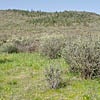
Perching
House Finch
Carpodacus mexicanus

Length: 6 in. (15 cm )
A native of the west, the House Finch is abundant in suburbs and cities but also does well in desert scrub and open woodlands. Because of its beautiful song, it was introduced to Long Island in the 1940s, and escapees and their offspring quickly populated much of the rest of the east. It feeds almost exclusively on seeds and unlike most other seed-eating species that switch to insects for their young, the House Finch also feeds seeds to its nestlings. This species uses a wide variety of nest sites, but the nest is often placed in a shaded niche or shallow cavity.\r\n
The four-digit banding code is HOFI.
Female | Robert Shantz(link is external)

Agricultural

Chaparral

Desert
Mesquite bosque
Riparian / River forest
Savanna

Shrubs

Urban city
View Citation
Be Part of
Ask A Biologist
By volunteering, or simply sending us feedback on the site. Scientists, teachers, writers, illustrators, and translators are all important to the program. If you are interested in helping with the website we have a Volunteers page to get the process started.














